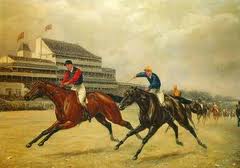All hail the Prince of Wales as his horse wins the Derby. It has been 108 years since a Prince (the future George IV) led his horse into the winner's circle at Epsom.
On a hard track despite a light morning rain, Persimmon, (Watts, the jockey, clad in the Prince's garish silks; purple with gold braid and scarlet sleeves and a black velvet cap with gold fringe!) goes off at 5-to-1. Lagging in the early stages, the Prince's colt catches the leaders at Tattersall's and, in a fierce stretch drive, edges the favorite, St. Frusquin (at 13-8), by a neck.
Some "railbirds" felt that had not St. Frusquin's jockey broken a stirrup the outcome might have been different. Other cynics in the paddock whispered that Leopold de Rothschild - owner of the favored colt - was known to harbor the thought that a win for the Royal stables would be for "the good of the sport of Kings." The theory gained more acceptance when St. Frusquin easily bested Persimmon in a rematch at Newmarket a short time later.
Still, no one will deny the Prince his triumph. Beaming proudly, he leads the horse himself through cheering crowds. The Prince returns to London that evening, several thousand pounds to the good, to host his annual Derby Day dinner for the "turf set" at Marlborough House. The salutes from the crowd outside his home and the good-natured chaff from his guests inside are genuine. The Times declares, "To win the Derby is much, but it is even more to know that a whole nation joins in congratulating him upon his success and in rejoicing because he is glad."
It is the first of three Derby wins for Bertie, his last (Minoru in 1909) coming whilst King. But Persimmon - who also won the prestigious St. Leger in 1896 - retained a special place in the King's memory. When the horse died of a fractured pelvis in 1908, the King mourned, "I have lost a trusty friend." He presented Persimmon's skeleton to the Natural History Museum in Kensington. A statue of the Derby champion stands at Sandringham.
A painting of the race by Major Godfrey (royalcollection.co.uk)

No comments:
Post a Comment